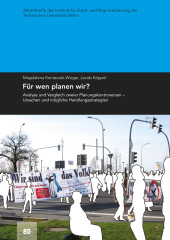Wohnperspektiven in der Berliner Innenstadt – Ein Entwicklungskonzept für zukunftsfähiges Wohnen im Columbia Quartier

Format: 21,0 x 29,7 cm
Publishing year: 2010
In view of the currently standing of inner cities for housing in this paper is examined the demand for housing development in the inner city of Berlin. Based on the hypothesis, inner city living will become important furthermore, there will be a demand in special market segments. At first – in a theoretic part – trends and prospects are shown which could substantiate new buildings for housing in an intra-urban area. Population development, quantitative house building and qualitative standards are the points for analysing a demand. The Columbia Quartier, a part of the now unused airport Berlin-Tempelhof, features special potentials to develop a sustainable housing area in consideration of identified perspectives. Special challenges are to resolve the deficits in social infrastructures, in no linked living areas and the currently unused open space. With this urbanistic concept possibilities are shown to realise a housing development considering on demands in many aspects. A conceptual focus is to present approaches to offer sustainable, efficient ecologic houses. The cogeneration of heat and power, using solar energy for electricity generation and a system to infiltrate rain water are three examples for it. Also an efficient soil using is considered in establishing infrastructures. Clearly identified objectives are important for developing this historical significant area and his adjacent areas. Some different suggestions are shown in this concept. But not only the efficient building has to be the challenge, also a determined allocation of land for building is important to settle different groups of population in an attractive new housing area.



